Related Research Articles
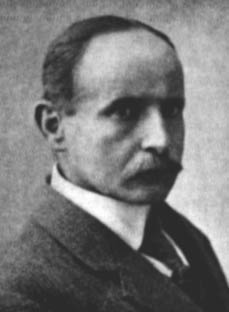
Friedrich Richard Rudolf Schlechter was a German taxonomist, botanist, and author of several works on orchids.

Acacia ligulata is a species of Acacia, a dense shrub widespread in all states of mainland Australia. It is not considered rare or endangered.

Eucalyptus macrorhyncha, commonly known as the red stringybark, is a species of medium-sized tree that is endemic to eastern Australia. It has rough, stringy, grey to brown bark, lance-shaped adult leaves, flower buds in groups of between seven and eleven, white flowers and hemispherical fruit.

Eucalyptus radiata, commonly known as the narrow-leaved peppermint or Forth River peppermint, is a species of tree that is endemic to south-eastern Australia. It has rough, fibrous to flaky bark on the trunk and larger branches, smooth grey bark on the thinner branches, lance-shaped to curved or almost linear leaves, flower buds in groups of eleven to twenty or more, white flowers and cup-shaped, hemispherical or shortened spherical fruit.
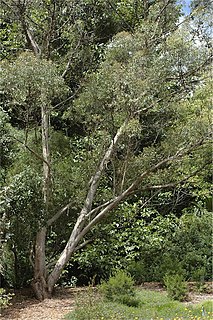
Eucalyptus olsenii, commonly known as the Woila gum, is a species of small tree that is endemic to a restricted area on the Southern Tablelands of New South Wales. It has smooth bark with rough bark on the lower trunk, lance-shaped to curved adult leaves, flower buds in groups of seven, white flowers and barrel-shaped or urn-shaped fruit.
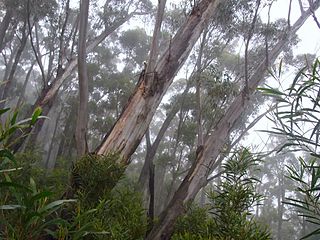
Eucalyptus stenostoma, commonly known as the Jillaga ash, is a small to medium-sized tree in that is endemic to a restricted part of New South Wales. It has rough, fissured bark on the lower trunk, smooth creamy white bark above, lance-shaped adult leaves, flower buds in groups of thirteen to nineteen or more, white flowers and spherical fruit with a small opening.

Telopea mongaensis, commonly known as the Monga waratah or Braidwood waratah, is a shrub or small tree in the family Proteaceae. Endemic to Australia, it grows at high altitude in south eastern New South Wales, where it is often seen in moist areas at the edge of rainforest or by streams in eucalyptus forests. Growing to 6 m (20 ft) high, it has narrow green leaves 4–18 cm (1.6–7.1 in) in length, and 0.5–2 cm (0.20–0.79 in) wide. In spring bears many red flowerheads, each made up of 28 to 65 individual flowers.

Dendrobium linguiforme, commonly known as the thumbnail orchid, tick orchid or tongue orchid, is a plant in the orchid family Orchidaceae and is endemic to eastern Australia. It grows on trees or on rocks, with wiry, prostrate stems, prostrate, fleshy leaves and spikes of up to twenty white to cream-coloured flowers in early spring.

Telopea aspera, commonly known as Gibraltar Range waratah, is a plant in the family Proteaceae. It grows as a woody shrub to 3 metres (10 ft) high with leathery rough leaves and bright red flower heads known as inflorescences—each composed of hundreds of individual flowers. It is endemic to the New England region in New South Wales in Australia. It was formally described as a species by botanists Peter Weston and Mike Crisp in 1995, separated from its close relative Telopea speciosissima by its rough foliage and preference for dryer habitat. Unlike its better known relative, Telopea aspera has rarely been cultivated.
Telopea is a fully open-access, online, peer-reviewed scientific journal that rapidly publishes original research on plant systematics, with broad content that covers Australia and the Asia-Pacific region. The journal was established in 1975 and is published by the National Herbarium of New South Wales, Royal Botanic Gardens & Domain Trust. As from Volume 9, part 1, 2000, full text of papers is available electronically in pdf format. It is named for the genus Telopea, commonly known as waratahs.

Persoonia myrtilloides, commonly known as myrtle geebung, is a plant in the family Proteaceae and is endemic to New South Wales. It is an erect to spreading shrub with elliptic to egg-shaped leaves and yellow flowers in groups of up to forty on a rachis up to 170 mm (6.7 in) long.

Eucalyptus langleyi, commonly known as the green mallee ash or albatross mallee, is a species of mallee that is endemic to a small area of New South Wales. It has mostly smooth grey to yellowish bark, lance-shaped to curved adult leaves, flower buds in groups of seven, white flowers and cup-shaped to barrel-shaped fruit.

Persoonia bargoensis, commonly known as the Bargo geebung, is a species of flowering plant in the family Proteaceae and is endemic to a restricted area of New South Wales. It is an erect shrub with linear to lance-shaped leaves, yellow, tube-shaped flowers and green, pear-shaped fruit.

The National Herbarium of New South Wales was established in 1853. The Herbarium has a collection of more than 1.4 million plant specimens, making it the second largest collection of pressed, dried plant specimens in Australia, including scientific and historically significant collections and samples of Australian flora gathered by Joseph Banks and Daniel Solander during the voyage of HMS Endeavour in 1770.
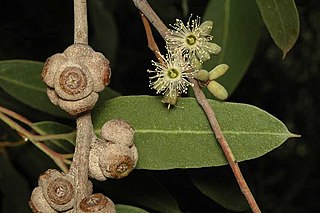
Eucalyptus bensonii, commonly known as Benson's stringybark, is a small tree or mallee that is endemic to New South Wales. It has rough grey or brown stringy bark on the trunk and larger branches, smooth bark on the thinnest branches, broadly lance-shaped to egg-shaped adult leaves, flower buds arranged in groups of seven, nine or eleven, white flowers and cup-shaped or hemispherical fruit in clusters.
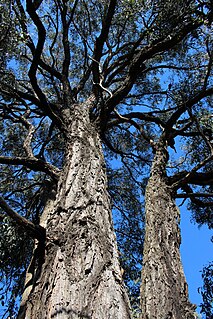
Eucalyptus beyeriana, commonly known as Beyer's ironbark, is a small tree that is endemic to New South Wales. It has dark grey to black "ironbark", lance-shaped adult leaves, flower buds in groups of seven, white flowers and cup-shaped to conical or shortened spherical fruit. Its name is disputed with some authors considering it to be a synonym of Eucalyptus beyeri.

Eucalyptus prava, commonly known as orange gum, is a species of small to medium-sized tree that is endemic to eastern Australia. It has smooth, mottled bark, lance-shaped or curved adult leaves, flower buds in groups of seven, white flowers and cup-shaped or hemispherical fruit.

Veronica plebeia, commonly known as creeping- or trailing speedwell, is a species of flowering plant belonging to the family Plantaginaceae. It is native to Australia and New Zealand.

Roger Charles Carolin is a botanist, pteridologist and formerly an associate professor at Sydney University. He was appointed as a lecturer in botany at the University of Sydney in 1955 earned a Ph.D from Sydney University in 1962 with a thesis on the floral morphology of the campanales, and retired as an associate professor in 1989.
Joy Thompson was an Australian botanist. Her main research areas were taxonomy and Myrtaceae.
References
- 1 2 "Blaxell, Donald Frederick (1934 - )". Biographical entry. Encyclopedia of Australian Science. Retrieved 16 September 2018.
- 1 2 "Blaxell, Donald Frederick (1934– )". Biographical Notes. Australian National Herbarium. Retrieved 16 September 2018.
- ↑ Uniken (2001) 1: UNSW people honoured
- ↑ IPNI. Blaxell.